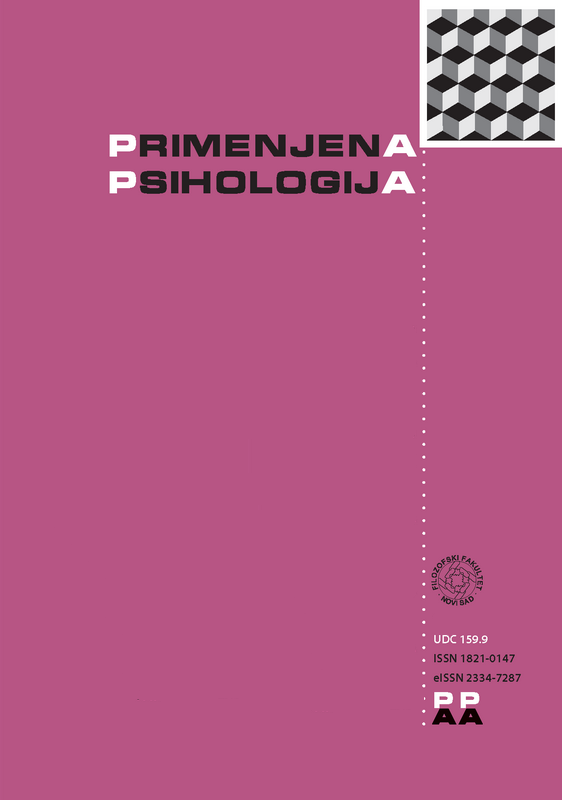VALIDACIJA SRPSKE ADAPTACIJE SKALE AUTENTIČNOSTI U PARTNERSKIM ODNOSIMA - (AIRS)
DOI:
https://doi.org/10.19090/pp.2018.1.89-104Ključne reči:
AIRS, autentičnost, partnerski odnosi, validacijaApstrakt
Cilj ovog istraživanja je bio provera nekih psihometrijskih karakteristika srpske adaptacije Skale autentičnosti u partnerskim odnosima (Authenticity in Relationships Scale – AIRS; Lopez & Rice, 2006). Na uzorku od 706 studenata je primenjena konfirmatorna faktorska analiza kojom je potvrđena dvofaktorskа strukturа. Faktori skale su Neprihvatanje obmane i Preuzimanje intimnog rizika. Na uzorku od 206 studenata je testirana konvergentna validnost i test-retest pouzdanost. Konvergentna validnost je proverena testiranjem korelacija dva faktora sa pozitivnim i negativnim afektom, samopouzdanjem, dimenzijama autentičnosti (autentični život, prihvatanje spoljašnjih uticaja, samootuđenost), zadovoljstvom partnerskim odnosom, zadovoljstvom podrškom partnera. Obe subskale imaju dobru pouzdanost interne konzistencije, ali veoma nisku test-retest pouzdanost, što ukazuje na nestabilnost autentičnosti u partnerskim odnosima studenata.
Reference
Bentler, P. M., & Bonett, D. G. (1980). Significance tests and goodness of fit in the analysis of covariance structures. Psychological Bulletin, 88, 588–606. doi:10.1037/0033– 2909.88.3.588
Byrne, B. M. (1994). Structural equation modeling with EQS and EQS/Windows. Newbury Park: Sage.
Cole, T. (2001). Lying to the one you love: The use of deception inromantic relationships. Journal of Social and Personal Relationships, 18, 107–129. doi:10.1177/0265407501181005
Didonato, T. E., & Krueger, J. I. (2010). Interpersonal affirmation and self-authenticity: A test of Rogers’s self-growth hypothesis. Self and Identity, 9, 322–336.
Gergen, K. J. (1991). The saturated self. New York: Basic Books.
Grégoire, S., Baron, L., Ménard, J., & Lachance, L. (2014). The Authenticity Scale: Psychometric Properties of a French Translation and Exploration of Its Relationships with Personality and Well-Being. Canadian Journal of Behavioural Science, 46(3), 346–355. doi: 10.1037/a0030962
Grijak, Đ. (2017). Psychometric evaluation of the Authenticity Scale on the sample of students in Serbia. Psihologija, 50(1), 85–99. doi: 10.2298/PSI160504001G
Harter, S., Marold, D. B., Whitesell, N. R., & Cobbs, G. (1996). A model of the effects of parent and peer support on adolescent false self behavior. Child Development, 67, 360–374. doi: 10.2307/1131819
İlhan, T., & Özdemir, Y (2013). Adaptation of Authenticity Scale to Turkish: A validity and Reliability Study. Turkish Psychological Counseling and Guidance Journal, 5(40), 142–153.
Jourard, S. M. (1971). The transparent self. New York: Van Nostrand.
Lopez, F. G., & Rice, K. G. (2006). Preliminary development and validation of a measure of relationship authenticity. Journal of Counseling Psychology, 53, 362–371. doi: 10.1037/0022-0167.53.3.362
Metts, S. (1989). An exploratory investigation of deception in close relationships. Journal of Social and Personal Relationships, 6, 159–179.
Mihić, Lj., Novović, Z., Čolović, P., & Smederevac, S. (2014). Serbian adaptation of the Positive and Negative Affect Schedule (PANAS): Its facets and secondorder structure. Psihologija, 47, 393‒414. doi:10.2298/PSI1404393M
Mitchell, S. A. (1992). True selves, false selves, and the ambiguity of authenticity. In N. J. Skolnick & S. C. Warshaw (Eds.), Relational perspectives in psychoanalysis (pp. 1–20). Hillsdale, NJ: Analytic Press
Neff, K. D., & Harter, S. (2002). The authenticity of conflict resolutionsamong adult couples: Does women’s other-oriented behavior affect theirtrue selves? Sex Roles, 47, 298–307.
Peterson, C. (1996). Deception in intimate relationships. International Journal of Psychology, 31, 279–288.
Robinson, O.C., Lopez, F.G., Ramos, K., & Nartova-Bochaver, S. (2012). Authenticity, Social Context and Well-Being in the United States, England, and Russia: A Three Country Comparative Analysis. Journal of Cross-Cultural Psychology, 44(5), 719–737. doi: 10.1177/0022022112465672
Rogers, C. R. (1961). On becoming a person: A therapist’s view of psychotherapy. London: Constable.
Rosenberg, M. (1965). Society and the adolescent self-image. Princeton, NJ: Princeton University Press.
Shamsi, A., Ghamarani, A., Samadi, M., & Ahmadzadeh, M. (2012). The Study Of The Validity And Reliability Of The Authentic Personality Scale. Journal Of Psychological Models and Methods, 2(8), 87–99.
Sheldon, K. M., Ryan, R. M. Rawsthorne, L. J., & Ilardi, B. (1997). Trait self and true self: Cross-role variation in the Big-Five personality traits and its relations with psychological authenticity and subjective well-being. Journal of Personality and Social Psychology, 73, 1380–1393. doi:10.1037/0022-3514.73.6.1380
Snyder, M. (1987). Public appearances/private realities: The psychology of self-monitoring. New York: Freeman.
Steiger, J. H., & Lind, J. C. (1980). Statistically-based tests for the number of common factors. Paper presented at the annual Spring Meeting of the Psychometric Society, Iowa City, Iowa.
Watson, D., Clark, L. A., & Tellegan, A. (1988). Development and validation of brief measures of positive and negative affect: The PANAS scales. Journal of Personality and Social Psychology, 54(6), 1063–1070.
Wood, A.M., Linley, P.A., Maltby, J., Baliousis, M., & Joseph, S. (2008). The authentic personality: A theoretical and empirical conceptualization and the development of the Authenticity Scale. Journal of Counseling Psychology 55(3), 385–399. doi: 10.1037/0022-0167.55.3.385







